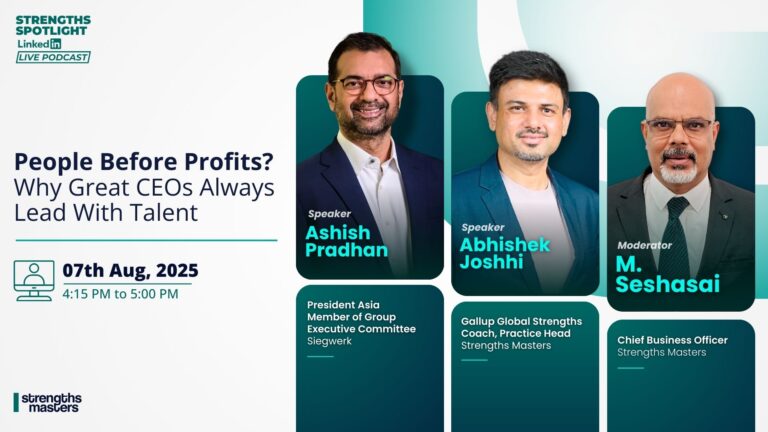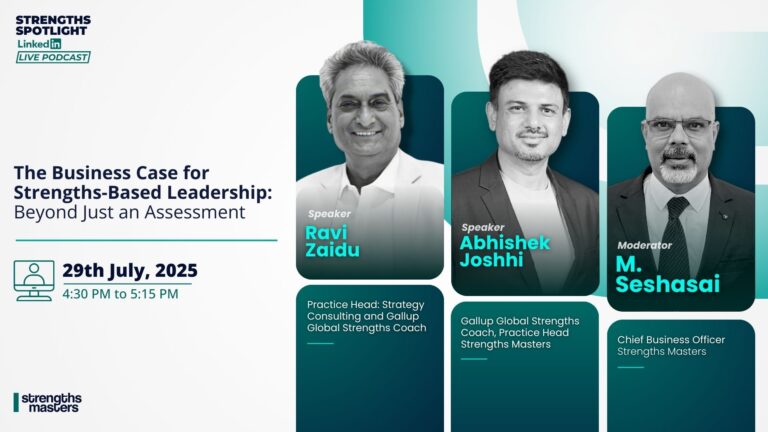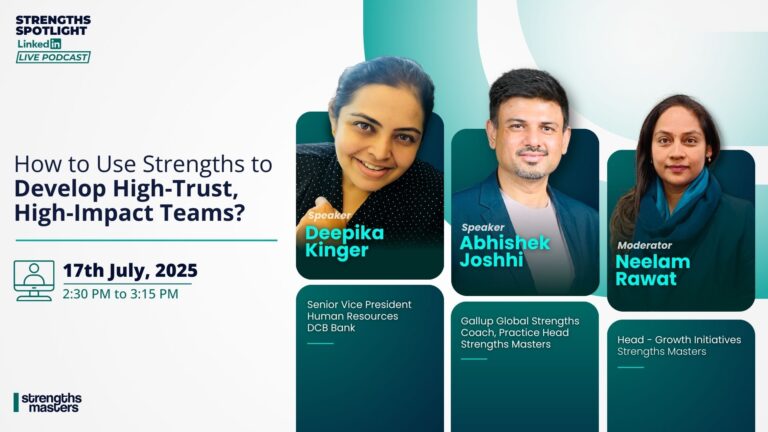A Strengths Spotlight Conversation with Kanwarpriya Khanna
In today’s hyper-competitive work landscape, high performers are often rewarded with promotions, raises, and recognition. But here’s the uncomfortable truth: those alone aren’t enough. The most driven individuals, the ones who lift teams, shift energy, and push the envelope, often disengage despite the incentives. So what really keeps them going? What fuels their passion once the bonuses are earned and the titles are awarded?
That’s exactly what we explored in our recent Strengths Spotlight LinkedIn Live session, hosted by Neelam from Strengths Masters. The topic, What Keeps High Performers Motivated Beyond Titles and Raises, touched a nerve for HR leaders, business heads, and coaches alike.
Meet the Speaker: Kanwarpriya Khanna
Joining us was the formidable Kanwarpriya Khanna, Director – HR at Aon and a respected voice in people leadership. Known for her ability to blend insight with empathy, Kanwarpriya has spent years studying high performers, not just how they show up, but how they thrive. Her experience spans across driving transformation, building high-impact talent strategies, and nurturing leadership from within. As she says, “High performers aren’t just meeting KPIs. They’re shifting the energy of the room.”
Unpacking the Discussion: What Truly Drives the Best?
The conversation kicked off by challenging a core assumption: that high performance is about output. Kanwarpriya reframed it powerfully: high performers don’t just meet expectations; they change the game. “They shift the energy of the room,” she said. “They look at problems and see possibilities. They act with purpose, urgency, and ownership, even when no one’s watching.”
But that very ownership often leads to a paradox. Organisations reward great work with more work, without pausing to invest back into the performer. As Kanwarpriya noted, “We stretch them… but forget to replenish them.” And slowly, silently, these top performers burn out, not because they lack resilience, but because they lack recognition that goes beyond the obvious.
Abhishek Joshhi added another layer: environment matters just as much as internal drive. “High performers come with a strong inner compass,” he said, “but if they aren’t nurtured, even the best flame dims.” Recognition that’s shallow, feedback that’s missing, or growth that’s flat, all can slowly detach even the most invested talent.
This isn’t about being nice. It’s about being intentional. As Kanwarpriya said, “If they don’t see their role in the future you’re building, they’ll stop building it with you.”
Five Key Lessons from the Spotlight
- Recognition Must Be Real, Not Routine
High performers can sniff out hollow praise. They crave feedback that is specific, meaningful, and forward-looking. For them, real recognition isn’t about claps or casual ‘good jobs.’ It’s being trusted with strategic decisions, invited into high-stakes rooms, or being publicly acknowledged for their influence, not just their effort. - Being Unseen is the Silent Killer
The most dangerous disengagement isn’t loud. It’s subtle. Kanwarpriya pointed out that when high performers feel unseen, they don’t create drama; they quietly switch to defence. “They’ll do the work, but not stretch. They’ll stop ideating. They’ll stop mentoring. And worst of all, they’ll start looking elsewhere… emotionally first, physically later.”
- Internal Mobility Isn’t a Luxury, It’s a Lifeline
Cross-functional exposure isn’t just a nice-to-have. For high performers, it’s essential. They seek complexity, challenge, and the thrill of learning. “Stagnation is the enemy,” said Kanwarpriya. Internal mobility sends a signal that the organisation sees them not in a box, but across business potential, and that builds deep, enduring loyalty.
- Strengths Unlock the Invisible
As Gallup-certified coach Abhishek Joshi added, strengths science offers managers a new lens. “It helps uncover not just what someone does well, but what makes them feel strong.” Through understanding the “basement” and “balcony” of strengths, leaders can decode hidden blocks, reignite stuck performers, and move from performance management to human development.
- Design Growth That Feels Personal, Not Positional
Career paths shouldn’t just climb, they should expand. Non-monetary growth isn’t low-value growth. It could be mentoring, a strategic challenge, a global rotation, or even a deeply personal gesture, like the time a leader sent a thank-you note not to Kanwarpriya, but to her family. “That letter is still on my desk,” she smiled. “The bonuses I forget. That moment, I remember.”
Final Thoughts: Performance is Personal. Retention is Relational.
The biggest takeaway from this session? Leading high performers isn’t about more tasks, more titles, or more cash. It’s about more meaning.
High performers don’t just want to win. They want to matter. They want to build. And they want to belong.
As Kanwarpriya so eloquently put it: “Treat them like internal entrepreneurs. Don’t just lead them, discover with them.”
For leaders and HR professionals, this is a call to action. Stop assuming. Start seeing. Invest emotionally, not just transactionally. Because when your best people feel truly seen, heard, and challenged, not only do they stay, they soar.
Quotable Highlights
- “They’re not artists if they’re not part of the strategic narrative.”
- “The moment they stop asking why, stop pushing back, that’s your red flag.”
- “Recognition that translates into influence, that’s what sticks with high performers.”
What’s Next
To watch the full conversation with Kanwarpriya Khanna and Abhishek Joshi, head over to the Strengths Masters Youtube Channel. And if you’re building a culture where top talent doesn’t just survive but thrives, reach out. We’d love to help.
Until next time, keep fueling the fire within your high performers, not just with rewards, but with respect, responsibility, and recognition that matters.
[Note: The views expressed by the speaker are their own and do not represent those of their organization.]





